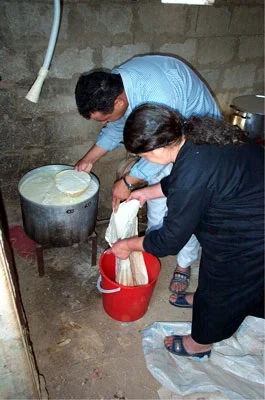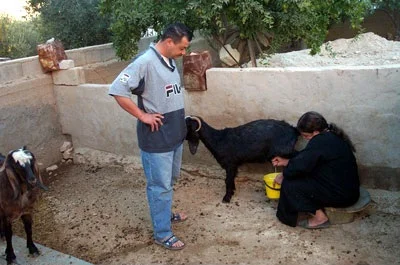Household milk processing
People in the village of Simakiyya are in transition from self-sufficiency to reliance on the commercial consumer market. Still there are those families in the village who milk their own sheep and goats, bake bread from the grain from their fields, process oil from their oil trees, grow small gardens of tomatoes and cucumbers, and keep a few chickens for eggs and meat. Probably the most involved and necessary of food preparation is the processing of their milk from sheep and goats. Women are totally responsible for the processing and it occupies a major part of their day.
Breakfast menu: eggs, bread, cheese, olive oil, thyme, butter and yogurt
The animals are milked twice a day, in the early morning and again in the late evening. During the dry summer months, when the grass is poor, the quantity of milk from each animal is low and milk processing is only necessary every three days. But in the spring when the animals are lactating after giving birth, the grass is heavy and the animals are fat, milk processing into food products must be done every single day. In June when this study was made, only about 10 animals in the herd of 30 were still being milked in the household of Umm-Saati' (literally, mother of Saati's), the mother of our research assistant, Saati'. Some had gone dry and several were sick. Still, these 10 animals gave enough milk to support the family of five and their visiting anthropologists. Although sheep milk has a higher fat content, goat and sheep milk are mixed and all the fresh milk goes into the same pail.
Nursing kid and milking sheep
Halib - fresh milk
Halib, the fresh milk is cleaned by pouring it through a thin cloth then dumping it into a plastic bucket with a cover and placed in a shaded place at the back of the house. A culture is added to the milk slowly changing it to yogurt, raayyib. After three days in the bucket, the fresh yogurt can be eaten but most of it is placed into a machine to shake. The villagers have very nicely adapted a small portable washing machine for this purpose and replaced the leather bag used for centuries and is still used today by the Bedouins. The only disadvantage of using the washing machine to stir the milk is that the machine heats up the milk, making it necessary for ice and cold water to be constantly added. But, the machine is very much a labor saving device given the fact that before women had to shake the large leather bag full of milk for three hours. The stirring is finished when the butter, zibda, has separated from the milk. The remaining liquid is called mukhir and is set aside for further processing. The ratio of butter to milk is about one to three. The family usually consumes all the butter but if sold, has a relatively low price at about 5 JD. ($7 USD) per kilogram.
Jamiid (a type of cheese) being skimmed from boiled milk
The muhkir, milk without butter, will then be heated for several hours but not to the boiling point until more of the milk solidifies. The solid is skimmed from the top of the mixture and placed into a cloth bag. Rocks are placed on top of the bag and left over night in order to press all the remaining liquid out of the solid. What results from this process is a type of cheese called jamiid and is a favorite of animal keepers. In order to preserve the cheese, salt is added and the coagulated cheese is pressed into round hard balls then put in the sun to dry. Jamiid can be kept up to a year without refrigeration because of the high salt content. Much of the jamiid made in household production is sold because it brings around 7 JD ($10 USD) a kilogram. F
Yogurt, butter, clarified butter oil and fresh baked bread
The butter, zibda, can be eaten on bread but most of it is further processed one more time into simna, clarified butter (oil butter). Simna is used for cooking and baking. For example, eggs fried in it are delicious and cookies made with the clarified butter are very tasty. More than three hours of work are involved in making simna because it must be slowly boiled with wheat bran and other spices until the oil separates out. The residue from any of the above processes is fed to the sheep and goats and nothing is thrown away. That includes the wheat bran that has absorbed the unwanted liquid during butter oil making.
There is still another milk product taken from the raw sheep and goat milk, halib and that is a white cheese known as jibna bira. It is a rather simple process compared to the steps involved in the products just described. The raw milk is put into a metal container and an enzyme added. The enzyme, masa, comes from the stomach of a lamb when it is butchered (or a synthetic enzyme can be purchased). In two hours the milk has solidified enough to put into a cloth bag and again the excess liquid is pressed out over night by stacking on rocks. In the morning the cheese is a firm round cake and put into a salt-water solution for keeping. Without refrigeration this white cheese, jibna bira, can be kept from four months to a year.
Women with their tending of the animals and processing of the milk contribute a major proportion of the family income. A village family where the matriarch becomes disabled or passes away will most likely have to sell their sheep and goats and discontinue this major source of family financial support. Although some of the younger people of Simakiyya know how to make all the milk products and often help their mothers, most do not have any desire nor are they encouraged to engage in this type of work. The youth prefer to work at paid employment and buy the milk, butter, yogurt, sour cream and cheese from the small village stores. Another option is for the family to hire a shepherd, milk their own animals and take the milk to a rural processing plant where the same products of zibda, simna, and jamiid are produced in market quantities. There is a rural process plant in the nearby town of Adir where commercial milk processing is available. The keeping of animals and the processing of milk is in transition in the village of al-Simakiyya as well as throughout Jordan and the change will have major consequences for the economic base of the household and the work that women have traditionally engaged in.
Saati and Umm-Saati milking goats





